





One of the Top Ten Plants at Daves Garden is Purple Heart (Purple Queen, Tradescantia pallida aka Setcreasea pallida or purpurea). A lanky ground cover with succulent leaves, it is very commonly grown in warmer climates (zones 8a-11), either purposely planted or springing up on its own. This plant is mostly grown for uniquely colored foliage that ranges from purple to reddish purple to green/purple depending on the conditions. To my eye, most Purple Heart is reddish or warm purple but you may see it differently as color perception varies somewhat. The foliage is made more complex by a grayish/blue dusky sheen. Despite its unusual color, Purple Heart is easy to mix into the landscape creating both vivid and subtle combinations of colors.
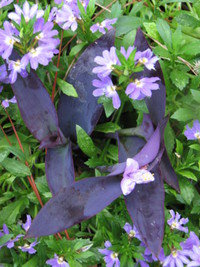 Purple Heart pairs nicely with purple flowered plants. Pairing analogous colors that are close together on the color wheel gives a harmonious and subtle effect. The purple neighbors seem to intensify each other. Some highly resiliant combinations include Purple Heart with Mexican Petunia (Ruellia brittonia), Fan Flower (Scaevola aemula) (pictured) and purple-flowered lantana (Lantana montevidensis 'Trailing Lavender'). Persian shield (Strobilanthes dyerianus) has lovely purple foliage that works well.
Purple Heart pairs nicely with purple flowered plants. Pairing analogous colors that are close together on the color wheel gives a harmonious and subtle effect. The purple neighbors seem to intensify each other. Some highly resiliant combinations include Purple Heart with Mexican Petunia (Ruellia brittonia), Fan Flower (Scaevola aemula) (pictured) and purple-flowered lantana (Lantana montevidensis 'Trailing Lavender'). Persian shield (Strobilanthes dyerianus) has lovely purple foliage that works well.
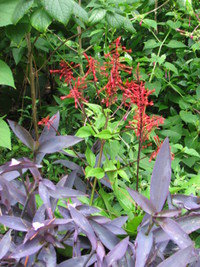 Red is also close to reddish purple on the color wheel. I have seen bright red flowered hibiscus and fire spike (Odontonema strictum) paired with Purple Heart in my neighborhood. For me however, this combo doesn't work possibly because the nearby bright red brings out the red undertones in Purple Heart and reminds me of, well, liver. When using a theoretical color scheme, personal taste still comes into play. One way to test a potential color combo is to get a pot of healthy plant and set it next to a possible companion and see if you like it. I like to assemble test groups of potted plants together at the nursery before I buy.
Red is also close to reddish purple on the color wheel. I have seen bright red flowered hibiscus and fire spike (Odontonema strictum) paired with Purple Heart in my neighborhood. For me however, this combo doesn't work possibly because the nearby bright red brings out the red undertones in Purple Heart and reminds me of, well, liver. When using a theoretical color scheme, personal taste still comes into play. One way to test a potential color combo is to get a pot of healthy plant and set it next to a possible companion and see if you like it. I like to assemble test groups of potted plants together at the nursery before I buy.

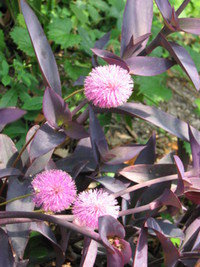


 f two pure colors are a bit much next to each other, maybe a toned down version of one will work. Each color on the wheel also comes with tints, tones and shades made by mixing white, grey or black respectively with the color. Tints, tones and shades are often less intense than the pure version of the color. Pink is a tint of red (red + white) that works quite well with Purple Heart. In fact, nature has picked pink flowers as a highlight for it’s red-purple foliage. The more intense pink flowers of four o’clock (Mirabilis jalapa), coneflowers (Echinacea purpurea) and Sunshine Mimosa (Mimosa strigillosa) (pictured) also sparkle when next to Purple Heart. Of course the classic, “just go ahead and try to kill us” parking lot combination is with Madagascar Periwinkle, (Vinca or Catharanthus roseus) Burgundy and rusts are shaded reds that works well adjacent to Purple Heart. Knot weed (Persicaria microcephala 'Red Dragon') and burgandy accented versions of Coleus or Canna pair nicely with Purple Heart.
f two pure colors are a bit much next to each other, maybe a toned down version of one will work. Each color on the wheel also comes with tints, tones and shades made by mixing white, grey or black respectively with the color. Tints, tones and shades are often less intense than the pure version of the color. Pink is a tint of red (red + white) that works quite well with Purple Heart. In fact, nature has picked pink flowers as a highlight for it’s red-purple foliage. The more intense pink flowers of four o’clock (Mirabilis jalapa), coneflowers (Echinacea purpurea) and Sunshine Mimosa (Mimosa strigillosa) (pictured) also sparkle when next to Purple Heart. Of course the classic, “just go ahead and try to kill us” parking lot combination is with Madagascar Periwinkle, (Vinca or Catharanthus roseus) Burgundy and rusts are shaded reds that works well adjacent to Purple Heart. Knot weed (Persicaria microcephala 'Red Dragon') and burgandy accented versions of Coleus or Canna pair nicely with Purple Heart.
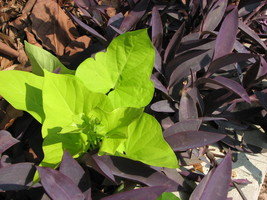
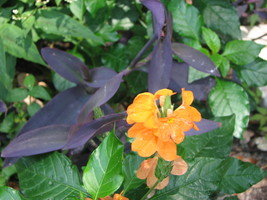
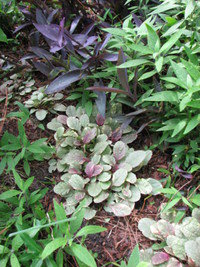
Color is never the only issue when combining plants. The new neighbors also need to have similar soil and water requirements. An aggressive companion can easily overrun a delicate little plant. Purple Heart should either be trimmed back regularly or be grown adjacent to plants that can hold their own. It spreads vigorously, self-seeds and is considered invasive by some. Check your State’s invasive plants list before choosing for your garden. Purple heart is not too choosey about location and can be in full sun to part shade, acid or alkaline soil. In fact, South of a freeze, it is as tough as nails. It's a good candidate to the sidewalk strip so, why not pull out that struggling grass and experiment with color?
(Editor's Note: This article was originally published September 13, 2009. Your comments are welcome, but please be aware that authors of previously published articles may not be able to respond to your questions.)
Copyright © www.100flowers.win Botanic Garden All Rights Reserved